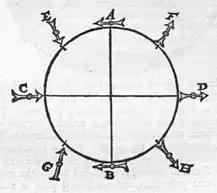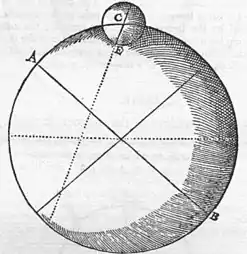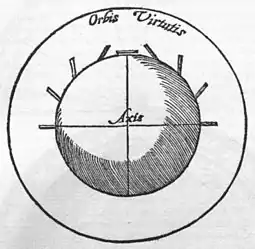CHAP. II.
Diagram of declinations of the magnetick needle, when
excited, in the various portions of the sphere, and horizons
of the earth, in which there is no variation
of the declination.


Here we have the level position of the magnetick needle on the æquator of the earth and the stone, at A and B, and its perpendicular position at C, D, the poles; whilst at the places midway between, at a distance of 45 degrees, the crosses of the needle dip toward the south, but the cusps just as much toward the north. Of which thing the reason will become clear from the demonstrations that follow.
* Diagram of the rotation and declination of a terrella
conforming to the globe of the earth, for a

A is the boreal pole of the earth or of a rather large terrella, B the southern, C a smaller terrella, E the southern pole of the smaller terrella, dipping in the northern regions[233]. The centre C is placed on the surface of the larger terrella, because the smaller terrella shows some variation on account of the length of the axis; inappreciable, however, on the earth. Just as a magnetick needle dips in a regional latitude of 50 degrees, so also the axis of a stone (of a spherical stone, of course) is depressed below the horizon, and its natural austral pole falls, and its boreal pole is raised on the south toward the Zenith. In the same way also a circular disc of iron behaves, which has been carefully touched at opposite parts on its circumference; but the magnetical experiments are less clear on account of the feebler forces in round pieces of iron.
Variety in the declinations of iron spikes at various latitudes of a terrella.

The declination of a magnetick needle above a terrella is shown by means of several equal iron wires, of the length of a barleycorn, arranged along a meridian. The wires on the æquator are directed by the virtue of the stone toward the poles, and lie down upon its body along the plane of its horizon. The nearer they are brought to the poles, the more they are raised up by their versatory nature. At the poles themselves they point perpendicularly toward the very centre. But iron spikes, if they are of more than a due length, are not raised straight up except on a vigorous stone.
The page and line references given in these notes are in all cases first to the Latin edition of 1600, and secondly to the English edition of 1900.
233 ^ Page 190, line 14. Page 190, line 19. declinans in Borealibus.—Dipping as it does in northern regions; that is, with the north-seeking or true-south pole downward.